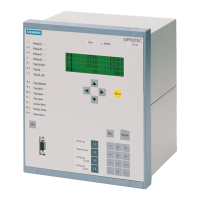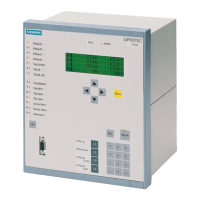Functions
2.44 Threshold supervision
SIPROTEC, 7UM62, Manual
C53000-G1176-C149-7, Release date 03.2010
302
2.44 Threshold supervision
This function monitors the thresholds of selected measured values (for overshoot or undershoot). The process-
ing speed of this function is so high that it can be used for protection applications. The necessary logical com-
binations can be implemented by means of CFC.
It is mainly used for high-speed supervision and automatic functions and application-specific protection func-
tions (e.g. disconnecting power plants) which are not included in the scope of protection functions.
2.44.1 Functional Description
Mode of Operation
There are 10 threshold supervision blocks, 5 each for reacting to overshoot and undershoot of the threshold.
As a result a logical indication is output that can be further processed by the CFC.
A total of 19 processable measured values are available, all of which can be evaluated as percentages. Each
threshold block can be allocated one of these 19 measured values.
The following table shows the useable measured values. The threshold values are queried once per cycle.
Note
The scaling of the percentage threshold values is exactly the same as for the operational measured values (see
Table 2-19 in Section 2.49.3). The settings of the power system data 1 are considered in the calculation. This
has to be taken into account for the applications.
Table 2-17 Measured Values
Measured Value Scaling Explanation
P
(Active power)
P
prim
/S
N,G,M
· 100 %
(normalized with addr. 252)
The positive sequence system quantities for U and I are formed
once per cycle from the scanned values. From the result, the
primary active power P is calculated. The measuring result is
subject to the angle correction (address 204 CT ANGLE W0) in the
current path.
Q
(Reactive power)
Q
prim
/S
N,G,M
· 100 %
(normalized with addr. 252)
The positive sequence system quantities for U and I are formed
once per cycle from the scanned values. From the result, the
primary reactive power Q is calculated. The measuring result is
subject to the angle correction (address 204 CT ANGLE W0) in the
current path.
ΔP
(Active power
change)
ΔP
prim
/S
N,G,M
· 100 %
(normalized with addr. 252)
The active power difference is calculated from the active power
over a measuring window of 3 cycles.
UL1E
(phase-earth volt-
age)
U
L1prim
/(U
N,G,M
/√3) · 100 %
(normalized via addr. 251/√3)
The voltage connected to the U
L1
input is processed directly, and
converted into the primary phase-earth voltage. The calculation is
performed once per cycle.
Note: The 100% value refers to the phase-earth voltage of the pro-
tected object.
UL2E
(phase-earth volt-
age)
U
L2prim
/(U
N,G,M
/√3) · 100 %
(normalized via addr. 251/√3)
The voltage connected to the U
L2
input is processed directly, and
converted into the primary phase-earth voltage. The calculation is
performed once per cycle.
Note: The 100% value refers to the phase-earth voltage of the pro-
tected object.

